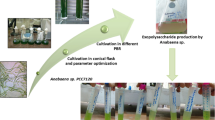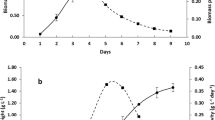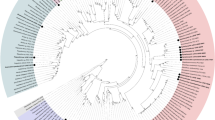Abstract
Microalgal extracellular polymeric substances (EPSs) are heteropolysaccharides that have characteristics suitable for industrial and biotechnological applications. Notably, they have strong anionic nature and high hydrophobicity. Nevertheless, systematic studies to demonstrate the viability of the production of EPSs on an industrial scale are still crucial. In this research, the chlorophyte Graesiella was grown on a raceway pond to view its EPS valorization. The biomass production achieved a maximum of 1.98 g L−1 and an EPS production of 1.6 g L−1 after six production days. The Graesiella EPSs with a molecular weight above 100 kDa are sulfated exopolymers containing mainly polysaccharide (70%) and protein (16%). The EPSs produced more stable emulsions with hydrocarbons and oils than Tween-20. The emulsification indices with n-hexane (88%) and maize oil (28%) indicate the EPSs’ strong emulsion-stabilizing capacity. The EPSs showed a peak flocculating percentage of 95% to kaolin suspension, with better flocculation performance than Al2(SO4)3 and alginate. Moreover, Graesiella EPSs had a significant effect on antimicrobial activity, significantly inhibiting fungal growth (71% for Botytis cinerea and 87% for Fusarium oxysporum), spore germination (100% of inhibition at a concentration of 1.8 g L−1), and mycelium growth (68% of inhibition). Also, Graesiella EPSs acted as a bactericide against Vibrio anguilaruim and Listonella anguilaruim (100% inhibition). EPSs were also found to have potent antioxidant activity compared with l-ascorbic acid. The obtained results open new perspectives to the further exploration of Graesiella sp. as a potential EPS producer, making it a promising candidate for numerous industrial applications.









Similar content being viewed by others
References
Abdul Khalil HPS, Lai TK, Tye YY, Rizal S, Chong EWN, Yap SW, Hamzah AA, Nurul Fazita MR, Paridah MT (2018) A review of extractions of seaweed hydrocolloids properties and applications. Express Polym Lett 12:296–317
Aljuboori AHR, Idris A, Abdullah N, Mohamad R (2013) Production and characterization of a bioflocculant produced by Aspergillus flavus. Bioresour Technol 127:489–493
Arad S, van Moppes D (2013) Novel sulfated polysaccharides of red microalgae: basics and applications. In: Richmond A, Hu Q (eds) Handbook of microalgal culture: applied phycology and biotechnology, 2nd edn. Wiley, NY, pp 406–416
Bafana A (2013) Characterization and optimization of production of exopolysaccharide from Chlamydomonas reinhardtii. J Carbohydr Polym 95:746–752
Bala Subramanian S, Yan S, Tyagi RD, Surampalli RY (2010) Extracellular polymeric substances (EPS) producing bacterial strains of municipal wastewater sludge: isolation, molecular identification, EPS characterization and performance for sludge settling and dewatering. Water Res 44:2253–2266
Ben Rebah F, Mnif W, Siddeeg SM (2018) Microbial flocculants as an alternative to synthetic polymers for wastewater treatment: a review. Symmetry 10:556
Bischoff HW, Bold HC (1963) Phycological studies. IV. Some soil algae from Enchanted Rock and related algal species. University of Texas Publication 6318:1–95
Brunchi CE, Bercea M, Morariu S, Dascalu M (2016) Some properties of xanthan gum in aqueous solutions: effect of temperature and pH. J Polym Res 23:126
Castellane TC, Persona MR, Campanharo JC, de Macedo Lemos (2015) EG production of exopolysaccharide from rhizobia with potential biotechnological and bioremediation applications. Int J Biol Macromol 74:515–522
Challouf R, Trabelsi L, Ben Dhieb R, El Abed O, Yahia A, Ghozzi K, Ben Ammar J, Omran H, Ben Ouada H (2011) Evaluation of cytotoxicity and biological activities in extracellular polysaccharides released by cyanobacterium Arthrospira platensis. Braz Arch Biol Technol 54:831–838
Chentir I, Hamdi M, Doumandji A, HadjSadok A, Ouada HB, Nasri M, Jridi M (2017) Enhancement of extracellular polymeric substances (EPS) production in Spirulina (Arthrospira sp.) by two-step cultivation process and partial characterization of their polysaccharidic moiety. Int J Biol Macromol 105:1412–1420
Conrad A, Suutari MK, Keinänen MM, Cadoret A, Faure P, Mansuy-Huault L, Block JC (2003) Fatty acids of lipid fractions in extracellular polymeric substances of activated sludge flocs. J Lipids 38:1093–1105
Craigie JS, Wen ZC, Van der Meer JP (1984) Interspecific and nutritionally-determination variations in the composition of agars from Gracilaria spp. Bot Mar 27:55–61
Debro LH, Ward HB (1979) Antibacterial activity of freshwater green algae. Planta Med 36:375–378
Delattre C, Pierre G, Laroche C, Michaud P (2016) Production, extraction and characterization of microalgal and cyanobacterial exopolysaccharides. Biotechnol Adv 15:1159–1179
Deng S, Bai R, Hu X, Luo Q (2003) Characteristics of a bioflocculant produced by Bacillus mucilaginosus and its use in starch wastewater treatment. Appl Microbiol Biotechnol 60:588–593
Desjardins P, Hansen JB, Allen M (2009) Microvolume protein concentration determination using the NanoDrop 2000c Spectrophotometer. J Vis Exp 33:1610
Dubois M, Gilles KA, Hamilton JK, Rebers PA, Smith F (1956) Colorimetric method for determination of sugars and related substances. Anal Chem 28:350–356
Duh PD, Tu YY, Yen GC (1999) Antioxidant activity of water extract of Harng Jyur (Chrysanthemum morifolium Ramat). LWT Food Sci Technol 32:269–277
Ekelhof A, Melkonian M (2017) Microalgal cultivation in porous substrate bioreactor for extracellular polysaccharide production. J Appl Phycol 29:1115–1122
El-Newary A, Ibrahim AY, Asker MS, Mahmoud MG, Awady ME (2017) Production, characterization and biological activities of acidic exopolysaccharide from marine Bacillus amyloliquefaciens 3MS 2017. Asian Pac J Trop Med 10:652–662
Fletcher I, Freer A, Ahmed A, Fitzgerald P (2019) Effect of temperature and growth media on mycelium growth of Pleurotus ostreatus and Ganoderma lucidum strains. Cohes J Microbiol Infect Dis 2:1–5
Folch J, Lees MBC, Stanley GHS (1957) A simple method for the isolation and purification of total lipids from animal tissues. J Biol Chem 226:497–509
Ghasemi Y, Moradian A, Mohagheghzadeh A, Shokravi S, Morowvat MH (2007) Antifungal and antibacterial activity of the microalgae collected from paddy fields of Iran: characterization of antimicrobial activity of Chroococcus dispersus. J Biol Sci 7:904–910
Gutiérrez T, Leo VV, Walker GM, Green DH (2009) Emulsifying properties of a glycoprotein extract produced by a marine Flexibacter species strain TG382. Enzym Microb Technol 45:53–57
Han P, Sun Y, Wu X, Yuan Y, Dai Y, Jia S (2014) Emulsifying, flocculating, and physicochemical properties of exopolysaccharide produced by cyanobacterium Nostoc flagelliforme. Appl Biochem Biotechnol 172:36–49
Hillmyer MA (2017) The promise of plastics from plants. Science 358:868–870
Hong M, Chen EYX (2017) Chemically recyclable polymers: a circular economy approach to sustainability. Green Chem 19:3692–3706
Hopewell J, Dvorak R, Kosior E (2009) Plastics recycling: challenges and opportunities. Phil Trans R Soc Lond B 364:2115–2126
Horozov TS, Binks BP, Gottschalk-Gaudig T (2007) Effect of electrolyte in silicone oil-in-water emulsions stabilised by fumed silica particles. Phys Chem Chem Phys 48:6398–6404
Kielak AM, Castellane TCL, Campanharo JC, Colnago LA, Costa OYA, Corradi da Silva ML, van Veen JA, Lemos EGM, Kuramae EE (2017) Characterization of novel Acidobacteria exopolysaccharides with potential industrial and ecological applications. Sci Rep 7:41193
Kim YD, Morr CV (1996) Microencapsulation properties of gum Arabic and several food proteins: liquid orange oil emulsion particles. J Agric Food Chem 44:1314–1320
Kishk YF, Al-Sayed H (2007) Free-radical scavenging and antioxidative activities of some polysaccharides in emulsions. LWT Food Sci Technol 40:270–277
Li WW, Zhou WZ, Zhang YZ, Wang J, Zhu XB (2008) Flocculation behavior and mechanism of an exopolysaccharide from the deep-sea psychrophilic bacterium Pseudoalteromonas sp. SM9913. Bioresour Technol 99:6893–6899
Li H, Li Z, Xiong S, Zhang H, Li N, Zhou S, Liu Y, Huang Z (2011) Pilot-scale isolation of bioactive extracellular polymeric substances from cell-free media of mass microalgal cultures using tangential-flow ultrafiltration. Process Biochem 46:1104–1109
Li Y, Li Q, Hao D, Hu Z, Song D, Yang M (2014) Characterization and flocculation mechanism of an alkali-activated polysaccharide flocculant from Arthrobacter sp. B4. Bioresour Technol 170:574–577
Lowry OH, Rosebrough NJ, Farr AL, Randall RJ (1951) Protein measurement with the Folin phenol reagent. J Biol Chem 193:265–275
Lv JM, Cheng LH, Xu XH, Zhang L, Chen HL (2010) Enhanced lipid production of Chlorella vulgaris by adjustment of cultivation condition. Bioresour Technol 17:6797–6804
Mansour MB, Dhahri M, Hassine M, Ajzenberg N, Venisse L, Ollivier V, Chaubet F, Jandrot-Perrus M, Maaroufi RM (2010) Highly sulfated dermatan sulfate from the skin of the ray Raja montagui: anticoagulant activity and mechanism of action. Comp Biochem Physiol B Biochem Mol Biol 156:206–215
Marklund S, Marklund G (1974) Involvement of the superoxide anion radical in the autoxidation of pyrogallol and a convenient assay for superoxide dismutase. Eur J Biochem 47:469–474
Martău GA, Mihai M, Vodnar DC (2019) The use of chitosan, alginate, and pectin in the biomedical and food sector: biocompatibility, bioadhesiveness, and biodegradability. J Polymers 1837:11–11
Mazeau K, Rinaudo M (2004) The prediction of the characteristics of some polysaccharides from molecular modeling. Comparison with effective behavior. Food Hydrocoll 18:885–898
McClements DJ, Bai L, Chung C (2017) Recent advances in the utilization of natural emulsifiers to form and stabilize emulsions. Annu Rev Food Sci Technol 28:205–236
Mezhoud N, Zili F, Bouzidi N, Helaoui F, Ammar J, Ouada HB (2014) The effects of temperature and light intensity on growth, reproduction and EPS synthesis of a thermophilic strain related to the genus Graesiella. Bioprocess Biosyst Eng 37:2271–2280
Michelson AM, McCord JM, Fridovich I (1977) Superoxide and superoxide dismutases. Academic Press, London 320 pp
Mishra A, Jha B (2009) Isolation and characterization of extracellular polymeric substances from micro-algae Dunaliella salina under salt stress. Bioresour Technol 100:3382–3386
Morowvat MH, Ghasemi Y (2016) Culture medium optimization for enhanced β-carotene and biomass production by Dunaliella salina in mixotrophic culture. Biocatal Agric Biotechnol 7:217–223
Mota R, Guimarães R, Büttel Z, Rossi F, Colica G, Silva CJ, Santos C, Gales L, Zille A, De Philippis R, Pereira SB, Tamagnini P (2013) Production and characterization of extracellular carbohydrate polymer from Cyanothece sp. CCY 0110. Carbohydr Polym 92:1408–1415
Mulcahy H, Charron-Mazenod L, Lewenza S (2008) Extracellular DNA chelates cations and induces antibiotic resistance in Pseudomonas aeruginosa biofilms. PLoS Pathog 4:e1000213
Nwodo UU, Green E, Okoh AI (2012) Bacterial exopolysaccharides: functionality and prospects. Int J Mol Sci 13:14002–14015
Okajima-Kaneko M, Ono M, Kabata K, Kaneko T (2007) Extraction of novel sulfated polysaccharides from Aphanothece sacrum (Sur.) Okada and its spectroscopic characterization. Pure Appl Chem 79:2039–2046
Parikh A, Madamwar D (2006) Partial characterization of extracellular polysaccharides from cyanobacteria. Bioresour Technol 97:1822–1827
Pereira S, Zille A, Micheletti E, Moradas-Ferreira P, De Philippis R, Tamagnini P (2009) Complexity of cyanobacterial exopolysaccharides: composition, structures, inducing factors and putative genes involved in their biosynthesis and assembly. FEMS Microbiol Rev 33:917–941
Qin Y, Liu S, Xing R, Yu H, Li K, Meng X, Li R, Li P (2012) Synthesis and characterization of dithiocarbamate chitosan derivatives with enhanced antifungal activity. Carbohydr Polym 89:388–393
Rafin C, Veignie E, Sancholle M, Postel D, Len C, Villa P, Ronco G (2000) Synthesis and antifungal activity of novel bisdithiocarbamate derivatives of carbohydrates against Fusarium oxysporum f. sp. Lini. J Agric Food Chem 48:5283–5287
Rana BK, Singh UP, Taneja V (1997) Antifungal activity and kinetics of inhibition by essential oil isolated from leaves of Aegle marmelos. J Ethnopharmacol 57:29–34
Raposo MFJ, Morais RMSC, Morais AMMB (2013) Bioactivity and applications of sulphated polysaccharides from marine microalgae. Mar Drugs 11:233–252
Raposo MFJ, Morais AMMB, Morais RMSC (2014) Influence of sulphate on the composition and antibacterial and antiviral properties of the exopolysaccharide from Porphyridium cruentum. Life Sci 101:56–63
Ruas-Madiedo P, de los Reyes-Gavilan CG (2005) Invited review: methods for the screening, isolation, and characterization of exopolysaccharides produced by lactic acid bacteria. J Dairy Sci 88:843–856
Schneiderman DK, Hillmyer MA (2017) 50th anniversary perspective: there is a great future in sustainable polymers. Macromolecules 50:3733–3749
Shimada K, Fujikawa K, Yahara K, Nakamura T (2002) Antioxidative properties of xanthan on the autoxidation of soybean oil in cyclodextrin emulsion. J Agric Food Chem 40:945–948
Sobeck DC, Higgins MJ (2002) Examination of three theories for mechanisms of cation-induced bioflocculation. Water Res 36:527–538
Valgas C, de Souza SM, Smânia EFA, Smânia A (2007) Screening methods to determine antibacterial activity of natural products. Braz J Microbiol 369-380:369–380
Wang Z, Ganewatta MS, Tang C (2020) Sustainable polymers from biomass: bridging chemistry with materials and processing. Prog Polym Sci 101:101197
Xiao R, Zheng Y (2016) Overview of microalgal extracellular polymeric substances (EPS) and their applications. Biotechnol Adv 15:1225–1244
Yun UJ, Park HD (2003) Physical properties of an extracellular polysaccharide produced by Bacillus sp. Cp912. Lett Appl Microbiol 36:282–287
Zhang J, Liu L, Chen F (2019) Production and characterization of exopolysaccharides from Chlorella zofingiensis and Chlorella vulgaris with anti-colorectal cancer activity. Int J Biol Macromol 134:976–983
Zhu C, Chen C, Zhao L, Zhang Y, Yang J, Song L, Yang S (2012) Bioflocculant produced by Chlamydomonas reinhardtii. J Appl Phycol 24:1245–1251
Zili F, Bouzidi N, Ammar J, Zakhama W, Ghoul M, Sayadi S, Ben Ouada H (2017) Mixotrophic cultivation promotes growth, lipid productivity, and PUFA production of a thermophilic Chlorophyta strain related to the genus Graesiella. J Appl Phycol 29:35–43
Acknowledgments
This work was supported by the Institute of Sciences and Technology of Tunisia and the Tunisian Ministry of Higher Education and Scientific Research. N. Cordeiro and JLG Pinchetti thanks the European Territorial Cooperation Programme PCT-MAC 2014-2020 through project REBECA-CCT (MAC/1.1.B/269). The authors thank Professor Sadok Saloua and Professor Daniel Montero for their help and support during the entire research period.
Author information
Authors and Affiliations
Corresponding authors
Additional information
Publisher’s note
Springer Nature remains neutral with regard to jurisdictional claims in published maps and institutional affiliations.
Electronic supplementary material
ESM 1
(DOCX 59 kb)
Rights and permissions
About this article
Cite this article
Gongi, W., Cordeiro, N., Pinchetti, J.L.G. et al. Production of exopolymer substances from the thermophilic chlorophyte Graesiella: industrial and ecological applications. J Appl Phycol 33, 343–356 (2021). https://doi.org/10.1007/s10811-020-02299-7
Received:
Revised:
Accepted:
Published:
Issue Date:
DOI: https://doi.org/10.1007/s10811-020-02299-7




